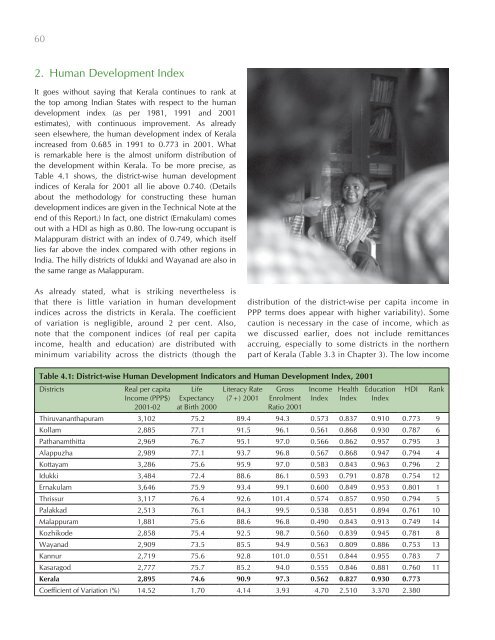Kerala 2005 - of Planning Commission
Kerala 2005 - of Planning Commission
Kerala 2005 - of Planning Commission
You also want an ePaper? Increase the reach of your titles
YUMPU automatically turns print PDFs into web optimized ePapers that Google loves.
60<br />
2. Human Development Index<br />
It goes without saying that <strong>Kerala</strong> continues to rank at<br />
the top among Indian States with respect to the human<br />
development index (as per 1981, 1991 and 2001<br />
estimates), with continuous improvement. As already<br />
seen elsewhere, the human development index <strong>of</strong> <strong>Kerala</strong><br />
increased from 0.685 in 1991 to 0.773 in 2001. What<br />
is remarkable here is the almost uniform distribution <strong>of</strong><br />
the development within <strong>Kerala</strong>. To be more precise, as<br />
Table 4.1 shows, the district-wise human development<br />
indices <strong>of</strong> <strong>Kerala</strong> for 2001 all lie above 0.740. (Details<br />
about the methodology for constructing these human<br />
development indices are given in the Technical Note at the<br />
end <strong>of</strong> this Report.) In fact, one district (Ernakulam) comes<br />
out with a HDI as high as 0.80. The low-rung occupant is<br />
Malappuram district with an index <strong>of</strong> 0.749, which itself<br />
lies far above the index compared with other regions in<br />
India. The hilly districts <strong>of</strong> Idukki and Wayanad are also in<br />
the same range as Malappuram.<br />
As already stated, what is striking nevertheless is<br />
that there is little variation in human development<br />
indices across the districts in <strong>Kerala</strong>. The coefficient<br />
<strong>of</strong> variation is negligible, around 2 per cent. Also,<br />
note that the component indices (<strong>of</strong> real per capita<br />
income, health and education) are distributed with<br />
minimum variability across the districts (though the<br />
distribution <strong>of</strong> the district-wise per capita income in<br />
PPP terms does appear with higher variability). Some<br />
caution is necessary in the case <strong>of</strong> income, which as<br />
we discussed earlier, does not include remittances<br />
accruing, especially to some districts in the northern<br />
part <strong>of</strong> <strong>Kerala</strong> (Table 3.3 in Chapter 3). The low income<br />
Table 4.1: District-wise Human Development Indicators and Human Development Index, 2001<br />
Districts<br />
Real per capita Life Literacy Rate Gross Income Health Education HDI Rank<br />
Income (PPP$)<br />
2001-02<br />
Expectancy<br />
at Birth 2000<br />
(7+) 2001 Enrolment<br />
Ratio 2001<br />
Index Index Index<br />
Thiruvananthapuram 3,102 75.2 89.4 94.3 0.573 0.837 0.910 0.773 9<br />
Kollam 2,885 77.1 91.5 96.1 0.561 0.868 0.930 0.787 6<br />
Pathanamthitta 2,969 76.7 95.1 97.0 0.566 0.862 0.957 0.795 3<br />
Alappuzha 2,989 77.1 93.7 96.8 0.567 0.868 0.947 0.794 4<br />
Kottayam 3,286 75.6 95.9 97.0 0.583 0.843 0.963 0.796 2<br />
Idukki 3,484 72.4 88.6 86.1 0.593 0.791 0.878 0.754 12<br />
Ernakulam 3,646 75.9 93.4 99.1 0.600 0.849 0.953 0.801 1<br />
Thrissur 3,117 76.4 92.6 101.4 0.574 0.857 0.950 0.794 5<br />
Palakkad 2,513 76.1 84.3 99.5 0.538 0.851 0.894 0.761 10<br />
Malappuram 1,881 75.6 88.6 96.8 0.490 0.843 0.913 0.749 14<br />
Kozhikode 2,858 75.4 92.5 98.7 0.560 0.839 0.945 0.781 8<br />
Wayanad 2,909 73.5 85.5 94.9 0.563 0.809 0.886 0.753 13<br />
Kannur 2,719 75.6 92.8 101.0 0.551 0.844 0.955 0.783 7<br />
Kasaragod 2,777 75.7 85.2 94.0 0.555 0.846 0.881 0.760 11<br />
<strong>Kerala</strong> 2,895 74.6 90.9 97.3 0.562 0.827 0.930 0.773<br />
Coefficient <strong>of</strong> Variation (%) 14.52 1.70 4.14 3.93 4.70 2.510 3.370 2.380

















